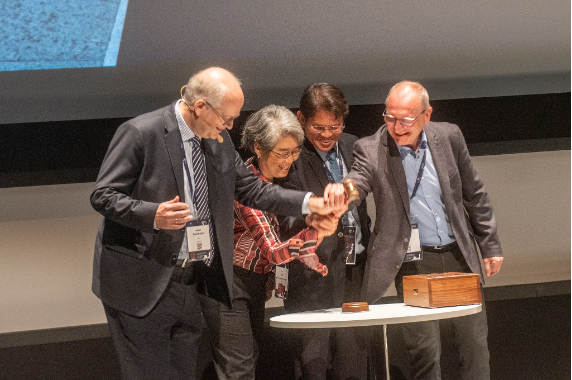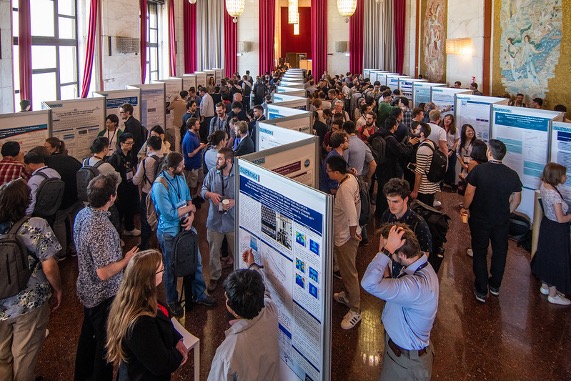
The 14th International Particle Accelerator Conference (IPAC23) took place from 7 to 12 May in Venice, Italy. The fully in-person event had record attendance with 1660 registered participants (including 273 students) from 37 countries, illustrating the need for real-life interactions in the global accelerator landscape after the COVID-19 pandemic. IPAC is not only a scientific meeting but also a global marketplace for accelerators, as demonstrated by the 311 participants from 121 companies present.
Following inspiring opening speeches by Antonio Zoccoli (INFN president) and Alfonso Franciosi (Elettra president) about the important role of particle accelerators in Italy, the scientific programme got under way. It included 87 talks and over 1500 posters covering all particles (electrons, positrons, protons, ions, muons, neutrons, …), all types of accelerators (storage rings, linacs, cyclotrons, plasma accelerators, …), all use-cases (particle physics, photon science, neutron science, medical and industrial applications, material physics, biological and chemical, …) and institutes involved across the world. The extensive programme offered such a wide perspective of excellence and ambition that it is only possible to highlight a short subset of what was presented.
Starting proceedings was a report by Malika Meddahi (CERN) on the successful LHC Injectors Upgrade (LIU) project. This project, with its predominantly female leadership team, was executed on budget and on schedule. It provides the LHC with beams of increased brightness as required by the ongoing luminosity upgrade, as later reported by CERN’s Oliver Brüning. The focus then shifted to advanced X-ray light sources. Emanuel Karantzoulis (Elettra) presented Elettra 2.0 – a new ultra-low emittance light source in construction in Trieste. Axel Brachmann (SLAC) updated participants on the status of LCLS-II, the world´s first CW X-ray free-electron laser (XFEL). While beam commissioning is somewhat delayed, the superconducting RF accelerator structures perform beyond the performance specification and the facility is in excellent condition. The week´s programme included an impressive overview by Dong Wang (Shanghai Advanced Research Institute) on the future of XFELs for which user demand has led to an enormous investment aiming in particular at “high average power”, which will be used to serve many more experiments including those for highly non-linear QED. Gianluca Geloni (European XFEL) showed that user operation for the world`s presently most powerful XFEL has been successfully enhanced with self-seeding. Massimo Ferrario (INFN) described the promise of a novel, high-tech plasma-based FEL being explored by the European EuPRAXIA project.

Jörg Blaurock (FAIR/GSI) presented the status of the €3.3 billion FAIR project. Major obstacles have been overcome and the completed tunnel and many accelerator components are now being prepared for installation, starting in 2024. The European Spallation Source in Sweden is advancing well and the proton linac is approaching full beam commissioning, as presented by Ryoichi Miyamoto (ESS) and Andrea Pisent (INFN). Yuan He from China (IMP, CAS) presented opportunities in accelerator-driven nuclear power, both in safety and in reusing nuclear fuels, and impressed participants with the news on a Chinese facility that is progressing well in terms of up-time and reliability. This theme was also addressed by Ulrich Dorda (Belgian Nuclear Research Centre) who presented the status of the Multi-purpose Hybrid Research Reactor for High-tech Applications (MYRRHA) project. Another impressive moment of the programme was Andrey Zelinsky’s (NSC in Ukraine) presentation on the Ukraine Neutron Source facility at the National Science Center “Kharkov Institute of Physics & Technology” (NSC KIPT). Construction, system checks and integration tests for this new facility have been completed and beam commissioning is being prepared under extremely difficult circumstances, as a result of Russia’s invasion.
Technological highlights included a report by Claire Antoine (CEA) on R&D into thin-film superconducting RF cavities and their potential game-changing role in sustainability. Sustainability was a major discussion topic throughout IPAC23, and several speakers presented the role of accelerators for the development of fusion reactors. The final talk of the conference by Beate Heinemann (DESY) showed that without accelerators, much knowledge in particle physics would still be missing and she argued for new accelerator facilities at the energy frontier to allow further discoveries.
The prize session saw Xingchen Xu (Fermilab), Mikhail Krasilnikov (DESY/Zeuthen) and Katsunobu Oide (KEK) receive the 2023 EPS-AG accelerator prizes. In addition, the Bruno Touschek prize was awarded to Matthew Signorelli (Cornell University), while two student poster prizes went to Sunar Ezgi (Goethe Universität Frankfurt) and Jonathan Christie (University of Liverpool).
IPAC23 included for the first time in Europe an equal opportunity session, which featured talks from Maria Masullo (INFN) and Louise Carvalho (CERN) on gender and STEM, pointing to the need to change the narrative and to move “from talk to targets”. The 300 participants in the session learnt about ways to improve gender balance but also about such important topics as neurodiversity. The very well attended industrial session of IPAC23 brought together projects and industry in a mixed presentation and round-table format.
For the organizers, IPAC23 has been a remarkable and truly rewarding effort, seeing the many delegates, industry colleagues and students from all over the world coming together for a lively, peaceful and collaborative conference. The many outstanding posters and talks promise a bright future for the field of particle accelerators.








